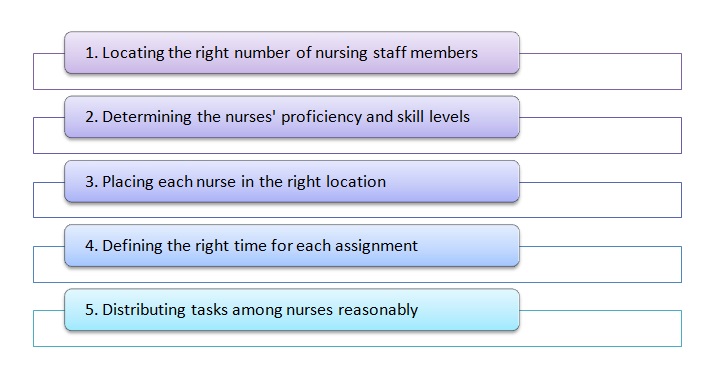Nurse-to-Patient Ratio and Acuity-Based Staffing Model Research Paper
The ABSM is not a new concept in nursing; according to Vortherms, Spoden, and Wilcken (2015), it has been used for quite a while as the means of addressing staffing issues in the acute care environment (Trepanier, 2017). The concept of ABSM is rather basic; as a rule, the framework implies that four elements should be introduced into the strategy for managing nursing processes. The elements in question include striking the right balance between the number of staff, their skill levels, placing nurses in the right location, providing a schedule with rigid deadlines, and assigning a set of responsibilities to each nurse based on their competence level (Shekelle, 2013).
Diagram

Figure 1. Acuity-Based Staffing Model (ABSM).
Reasons for Using the ABSM
The application of the ABSM is crucial to the management of the issues associated with a low NPR. The framework allows approaching the problem of low staffing levels from different angles, therefore, considering the factors that affect it most. Indeed, a closer look at the suggested approach will show that it helps resolve the problem by determining the right location for each nurse. Furthermore, the low staffing levels are addressed by defining the density of nurses per each section so that the needs of patients with different health records could be addressed respectively. The identification of the nurses’ knowledge and skills will help select the appropriate assignments for them so that they could manage the provided tasks efficiently. The specified step will allow reducing the number of workplace burnouts in the environment of a nursing facility since each nurse will be given the number of tasks that they will be able to handle (Barton, 2013).
Furthermore, the model creates opportunities for reconsidering the approach toward time management. As shown in the diagram above, the ABSM focuses on distributing the available time efficiently so that each assignment could be completed within the set deadline. As a result, the threat of delays will be reduced significantly. The specified outcome will lead to a massive drop in negative outcomes among patients. Furthermore, with a more coherent time management framework, nurses will be able to get enough rest to manage their tasks efficiently. Indeed, a closer look at the model will reveal that it helps redesign the current approach toward time management by relocating nurses and redistributing their assignments so that each task could correspond to a nurse’s skill level and knowledge of the required area of nursing (Hill, 2017).
Conclusion
Possible Issues in the ABSM Implementation
The adoption of the ABSM is likely to lead to a massive improvement in improving the NPR. The framework helps embrace the key factors that affect the drop in the NPR and the following increase in the workplace burnout rates among nurses, as well as the reduction in nursing service quality. However, there might be some difficulties in implementing the model due to the limitations of the ABSM.
At present, there are two issues to consider. The fact that the model only works once the existing NPR is not very low should be mentioned first. The framework does not contribute to the increase in the number of nurses in the environment of a particular nursing facility; instead, it helps rearrange the tasks so that each nurse could have the number of responsibilities that they could handle. Therefore, it cannot be used in the instances of a significant drop in the NPR. Furthermore, the fact that it does not provide rigid guidelines concerning the rearrangement of responsibilities and the redesign of the schedule should be listed among the key concerns.
Improvement Measures
To enhance the efficacy of the model, one should consider introducing opportunities for professional growth for nurses. For instance, courses and training sessions during which the staff members will be able to acquire new skills and knowledge should be deemed as possible devices for enhancing the efficacy of the ABSM. As a result, nurses will learn to handle their tasks within a comparatively short amount of time and at the same time meet the required quality levels
Order this paper